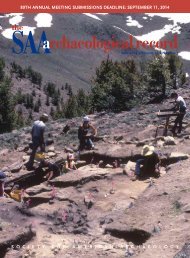SAA
SAA_Record_Nov2015
SAA_Record_Nov2015
You also want an ePaper? Increase the reach of your titles
YUMPU automatically turns print PDFs into web optimized ePapers that Google loves.
PROS AND CONS OF CONSULTING COLLECTORS<br />
for investigations at Poverty Point. Further, the interpretative<br />
significance on which Poverty Point was successfully argued<br />
to merit a UNESCO World Heritage Site designation would<br />
have been dramatically weakened without the surface-collected<br />
material of Carl Alexander. Of note, no other archaeologist,<br />
professional or avocational, conducted the type of<br />
extensive surface collections as did Alexander when the site<br />
was in row crop. Such a method is not feasible today from<br />
both logistical and preservation perspectives.<br />
Amateur Archaeology at the Jaketown Site<br />
In the late 1990s, during my tenure as the Station Archaeologist<br />
at the Poverty Point site, I gave several presentations at<br />
the public library in Belzoni, Mississippi, just down the road<br />
from the Poverty Point culture Jaketown site (22Hu505). The<br />
presentations were attended by collectors from the area,<br />
many of whom brought their artifacts to the meeting for<br />
identification. In my first presentation, I spoke about the<br />
spatial distribution of artifact types noted by Webb and<br />
Alexander at Poverty Point. I asked the collectors in attendance<br />
whether they had noted similar patterns in the different<br />
types of artifacts recovered at Jaketown. Heads nodded.<br />
The second time I spoke in Belzoni, the same collectors<br />
talked about the artifact distributions they had noted during<br />
my previous presentation. Today, there is a small museum in<br />
Belzoni composed of collections donated by many of those<br />
collectors. My Belzoni experience is an example of avocational<br />
archaeologists (Webb and Alexander) training other avocational<br />
archaeologists, with the professional as an intermediary,<br />
a phenomenon also noted by avocational Jim Cox in his<br />
essay in this issue of The <strong>SAA</strong> Archaeological Record.<br />
The Claiborne Site and Jerry Pankow<br />
I first met Jerry Pankow in the early 2000s. He had come to<br />
the Poverty Point site to discuss his “amateur” archaeology<br />
excavations at the Poverty Point culture Claiborne site in<br />
Hancock County Mississippi. In the 1960s, Jerry and members<br />
of the Mississippi Archaeological Association diligently<br />
conducted excavations at this major Poverty Point culture<br />
site in advance of bulldozers that destroyed the site in a construction<br />
project. Jerry showed me his detailed field notes of<br />
5-x-5-ft. units excavated through midden deposits at the Claiborne<br />
site. He recorded cultural materials in arbitrary 5-inch<br />
levels, providing an excellent stratigraphic profile on stylistic<br />
and material culture change through time— a point of critical<br />
interpretive importance for the Poverty Point culture. The<br />
temporal markers were also documented by Clarence Webb.<br />
When I first met Jerry, he had just self-published a 35-page<br />
photocopied pamphlet on his excavations at the Claiborne<br />
site. While preparing my comments for the 2015 <strong>SAA</strong><br />
forum, I discovered that, in 2014, Jerry had expanded the<br />
original publication to double the length, again self-published<br />
but now also available online. I got a copy and am<br />
impressed.<br />
Discussion<br />
My experiences with avocational archaeologists at the Poverty<br />
Point site demonstrate several points. The contributions of<br />
avocational archaeologists are a critically important part of<br />
the total corpus of knowledge that exists about that prehistoric<br />
culture today. Those contributions demonstrate that,<br />
without question, our understanding of the socioeconomic<br />
organization of the culture and site would be greatly reduced<br />
were it not for these avocational contributions.<br />
The contributions of avocational archaeologists at Poverty<br />
Point are considerable and varied. Although Clarence Webb<br />
had no formal archaeological training, because of his educational<br />
background in medicine and his considerable publication<br />
record in peer-reviewed and other journals, I suspect<br />
that the inclination is to treat him as somehow different or<br />
better than Carl Alexander, who retired from the U.S. Navy<br />
and, to my knowledge, published nothing. Yet Ford and<br />
Webb were prepared to completely rewrite their 1956 type<br />
site report based on Alexander’s surface collections.<br />
A clear trend through time has been to dismiss rather than<br />
engage the avocational community in research projects. That<br />
community is often considered from the perspective of a<br />
deficit model (Merriman 2004:6–11), in which the professional<br />
archaeologist is charged with the proper education of<br />
the public. Today, Clarence Webb or Carl Alexander probably<br />
would not be able to make their way onto an archaeological<br />
site, regardless of the experiential credentials they might<br />
bring. Their activities would be limited to volunteer projects<br />
of artifact inventory, screening sediments, or participating in<br />
a field school. Their expressed interests in archaeology<br />
would not be developed, except through their enrollment in<br />
a degree program at a local university.<br />
However, concerns over the looting of archaeological<br />
resources, the commodification of this country’s cultural heritage,<br />
and a lack of public funding for archaeological<br />
research are all concerns expressed by the professional community.<br />
We are well-served to embrace the avocational community<br />
who have a proven track record and can develop the<br />
grassroots support to address these issues. Such engage-<br />
22 The <strong>SAA</strong> Archaeological Record • November 2015




